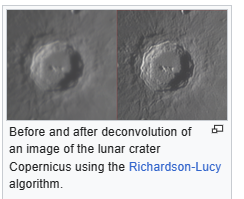Glossary |
Deconvolution |
updated: 2024-03-18 |
In mathematics, deconvolution is the inverse of convolution. Both operations are used in signal processing and image processing. For example, it may be possible to recover the original signal after a filter ( convolution) by using a deconvolution method with a certain degree of accuracy.[1] Due to the measurement error of the recorded signal or image, it can be demonstrated that the worse the signal-to-noise ratio (SNR), the worse the reversing of a filter will be; hence, inverting a filter is not always a good solution as the error amplifies. Deconvolution offers a solution to this problem.
The foundations for deconvolution and time-series analysis were largely laid by Norbert Wiener of the Massachusetts Institute of Technology in his book Extrapolation, Interpolation, and Smoothing of Stationary Time Series (1949).[2] The book was based on work Wiener had done during World War II but that had been classified at the time. Some of the early attempts to apply these theories were in the fields of weather forecasting and economics.

Picture reference: Deconvolution - Wikipedia
Examples of Deconvolution tools can be found e.g. in PixInsight, such as:

- BluxXTerminator (an AI based plugin forPixInsight )
- Deconvolution: provides different deconvolution algorithms:
- Richardson-Lucy (also regularized)
- Van Cittert (also regularized)
- RestorianFilter
- Constrained Least Square Filtering
- Wiener Filtering
Reference: Deconvolution - Wikipedia
Created with the Personal Edition of HelpNDoc: Create iPhone web-based documentation
